In a hostile, very red environment, Notre Dame was able to create the same number of scoring opportunities as Georgia, and hang close in efficiency and explosiveness. What were the advantages that tipped the scales in the Bulldogs favor, and what encouraging signs and questions remain for the rest of the season, where the Irish are expected to be favored in every game?
No garbage time in this game that came down to a final Irish drive for the upset win. Notably, both teams played at a slow pace, with only 61 plays for the Irish and 57 for the Dawgs excluding kneel-downs.
Explosiveness
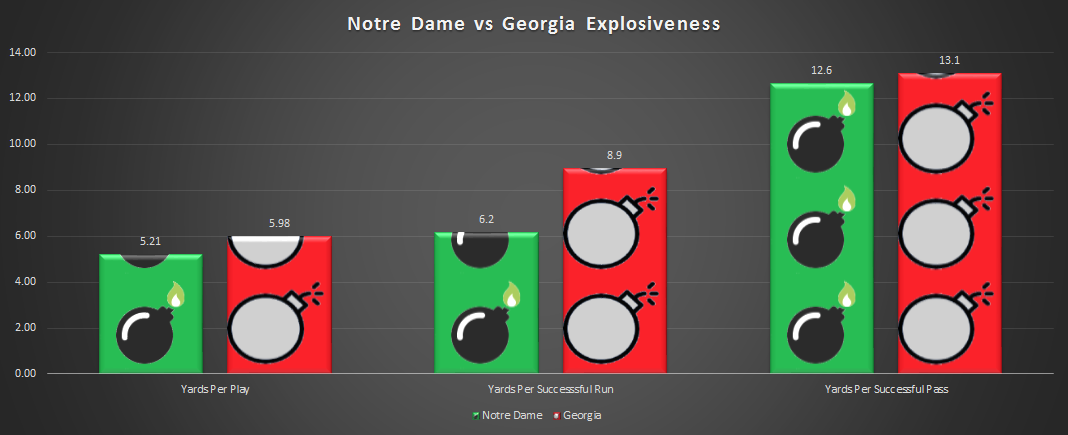
Two huge questions entering the game were if Notre Dame could contain Georgia’s explosive skill position talent and if the Irish could manufacture enough explosive plays to win. The Irish defense was up to the task; the offense only somewhat, and not at key moments. Both offenses struggled to manufacture big plays on the ground – Deandre Swift and the Dawgs had a long run of 16 yards, and the longest for the Irish a 9-yard Book scramble.
UGA outgained Notre Dame by 0.77 yards per play – not a huge margin, but one that historically results in a win 72% of the time and an average scoring margin advantage of about a touchdown. Stack up the longest plays by each team and you’ll see the Irish held fairly even in explosive plays over 15 yards, but weren’t able to stack up as much production in the remaining plays (Notre Dame ran four more plays and had more incompletions, so the negative plays don’t exactly match up):

This was a masterpiece of a performance by Clark Lea with the defense. Every unit played at a high level – the defensive line holding serve against the OL hyped up as the best in the nation, linebackers flying the ball and containing the UGA backs, and secondary draped on UGA receivers. Neither team was able to come away with a sack – some early pressure from the Irish almost resulted in a turnover, but Jake Fromm was poised under pressure and got the ball out quickly.
The Irish still managed a solid havoc rate fueled by run stuffs and tackles for losses. Drew White and Jeremiah Owusu-Koramoah had outstanding games, with each stepping in for massive stops that put Georgia into passing downs. The Irish had just two pass break ups on the night, a testament to how careful Fromm was with the football in his decision-making and ability to put several throws in places only his guys had a chance to make the play.
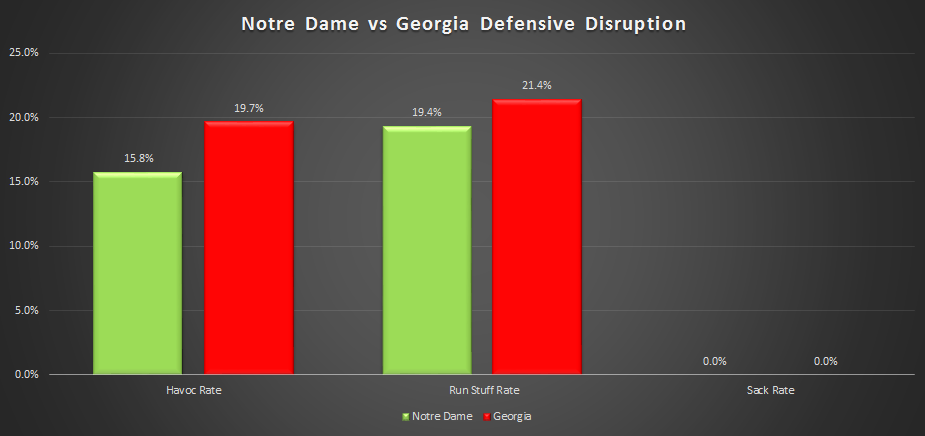
The one question mark this brings up defensively is how well this type of performance can be replicated. Defensive rotations were tightened, and a consequence was a drop-off in effectiveness in the second half despite Georgia running just 57 plays in the game. The Irish also seemed to benefit in run defense was a QB that wasn’t an active part of the run game, and will have to re-adjust quickly to Bryce Perkins next week.
Still, it was a pretty perfectly executed bend but don’t break in Athens. The two Georgia touchdown drives were 8 plays, 82 yards, and 13 plays, 75 yards. The Irish forced Fromm and company to win on passing downs, but unfortunately they were up to the task and created a lot of successful plays with a high degree of difficulty forced by the ND defense.
Efficiency
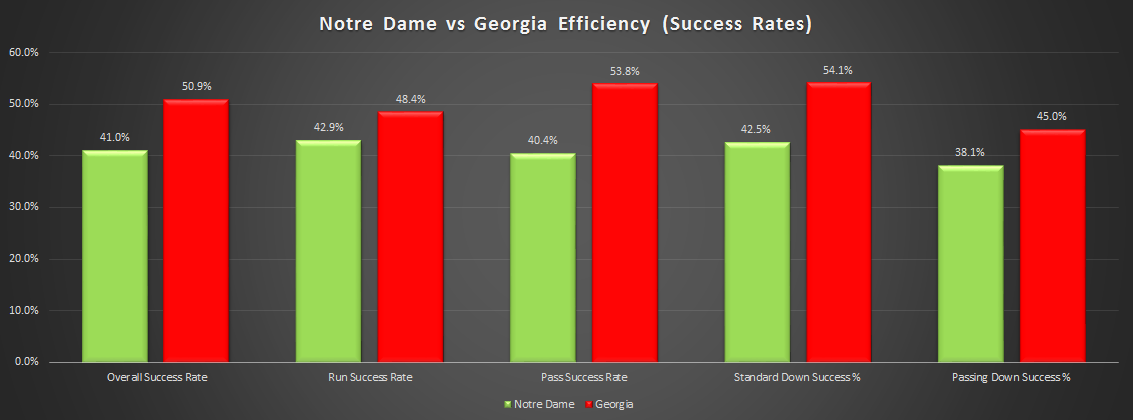
The Irish were less efficient in all situations than Georgia, with the biggest disparity coming in pass game success rate. Explosive plays and the ability to sequence a few of those together provided enough spark for the Notre Dame offense to stay in striking range, but Fromm was extremely strong on passing downs.
I was a little bit surprised by the Irish success rate running the ball, even with a small sample size. But it obscures the truth a bit – the Irish were successful on three of five non-RB carries (two by Lawrence Keys, two by Book), but just three of nine of Tony Jones Jr.’s, the only back to receive a rushing attempt. For the game run attempts averaged 3.29 yards per carry and passes 5.79 per drop back, and as someone who has in the past advocated for going all-in on what you perceive as your biggest strength in big games, I thought it was a strong game plan by Chip Long.
| Leverage Rate | Average 1st Down Gain | Average 3rd Down Distance | 3rd Down Conversion % | |
| Notre Dame | 65.6% | 4.84 | 7.00 | 30.8% |
| Georgia | 64.9% | 5.77 | 8.82 | 45.5% |
While ND actually had an advantage on average third down distance to go, the Irish converted less of these opportunities and could have had an even greater edge. As Eric detailed in his recap, the inability to communicate well with the snap count (at times reacting to UGA’s stemming, other times with Book reverting to a different system) was killer in a close contest. A quick overview:
- On the first drive of the game, the Irish gained 41 yards on their first four official offensive plays. This could have put them in 1st and 10 at the UGA 34, but instead, since it was sandwiched between a personal foul and false start, the Irish were only at their own 45 and punted.
- After an awful punt gave the offense the ball at the UGA 40, a false start pushed things far behind schedule for a 2nd and 14. The offense couldn’t recover and ended up with no points out of a scoring opportunity.
- Just before the half, with a golden opportunity to go up 14-7 (1st and 10 on the Dawgs 12), a false start puts the offense again behind the chains and causes a 10 second run-off. To compound the error, the Irish then hesitate after a completion in bounds and then call timeout once 10 seconds or so have run off the clock.
The immediate aftermath of the game turned into another discussion of what the ceiling for this offense is with Ian Book, debate over whether or not he played well, and whether the chasm in running back talent was a key determining factor in the game. None of these have clear answers – on the positive side, Book was comfortable in the pocket against a very good UGA defense that tried to confuse him. The return of Cole Kmet was a huge lift, and while Chase Claypool had a monster game he was also not an efficient target until down the stretch. Unfortunately this was a poor Chris Finke game, although Lawrence Keys had a couple nice plays to compensate.
Ultimately I think the fairest assessment is that Book remains good to very good but not great, which isn’t disparaging him. He brings some terrific traits to the table in terms of his short to medium accuracy and efficiency, which has returned to normal since Louisville. As a whole his decision making remains pretty good, especially when he’s comfortable and steps up in the pocket against the pass rush (much better against UGA, with some room still for growth).
The limitations feel to me like his ability to anticipate and react. When Chip Long calls a winning play, there’s clear talent advantages, and primary reads are open, Book is great. In games like last weekend’s, when often those things don’t or won’t come together in the matchup, Book has a hard time making things happen on his own. Again, this isn’t a knock, as there’s probably a handful of QBs at best that could do that against the UGA defense.
But it’s understandably tantalizing and frustrating for Irish fans, because after last season the prospect that Book would emerge as that kind of difference-maker felt like it was on the table. The lack of a consistent running threat doesn’t help him or the offense as a whole by placing a tremendous weight on his shoulders. But to beat playoff caliber teams with Book it feels like it requires a combination of skill position or schematic advantages (a Chip Long masterpiece), potentially both.
The preseason conversation about this Irish team largely assumed that to be a playoff team, Book would need to take a leap and lead a dynamic offense whose growth would offset some expected regression with key personnel losses on defense. The defense looks like it may recover better than expected, but the lack of dynamic offense just puts a ceiling on offense other playoff teams don’t have. And I think fans are hard on Book because he’s good enough to easily imagine with these ’18 and ’19 defenses how a QB just one tier higher might be able to maybe lead to greatness. It’s not that Book isn’t very good, it’s just may be even harder to accept his performances because he’s close enough to tease us.
Finishing Drives, Field Position & Turnovers
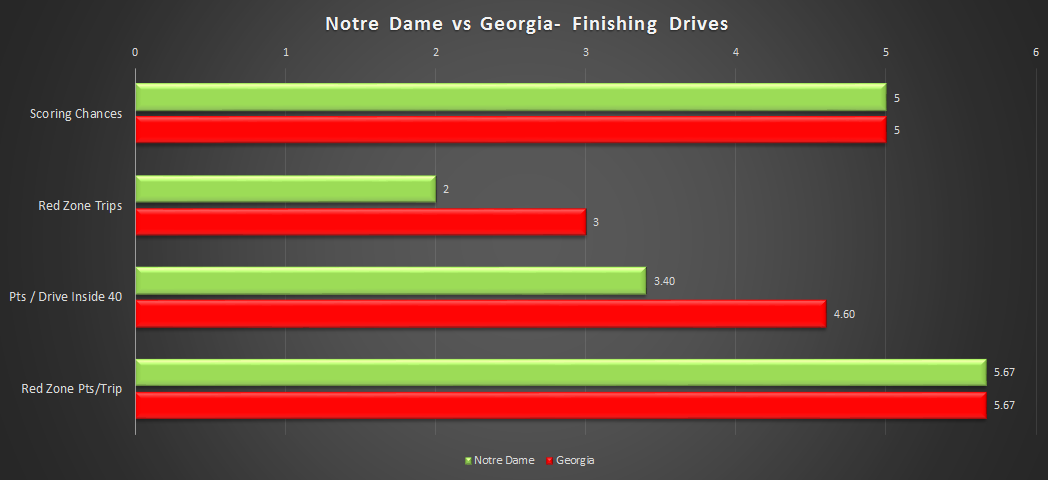
The Irish were able to manufacture an equal five scoring opportunities in the game, capitalizing off some Georgia special teams miscues for two of those chances. Unfortunately the Notre Dame offense came up empty in the first and last of those chances. The drive starting at the UGA 40 after a terrible Georgia punt in the first quarter ended with a bad snap and desperation Book heave on 4th and 2 on the Georgia 32. The final drive ended with a similar image – Book running backwards from Bulldog pressure and throwing one up for grabs from the Dawgs 38-yard line.
While the ND defense performed admirably, the Bulldogs scored on each of their scoring opportunities, cashing in two touchdowns and three Rodrigo Blankenship field goals. Kirby Smart played a pretty conservative game, as has been his habit, and definitely gifted the Irish some life down the stretch settling for a field goal on 4th and 1 to extend the lead from 10 to 13 instead of going for the jugular. A conversion, probably 70% likely or more in that situation, probably ensures the Irish don’t have a last chance – even settling for a closer field goal would likely waste enough time to secure things.
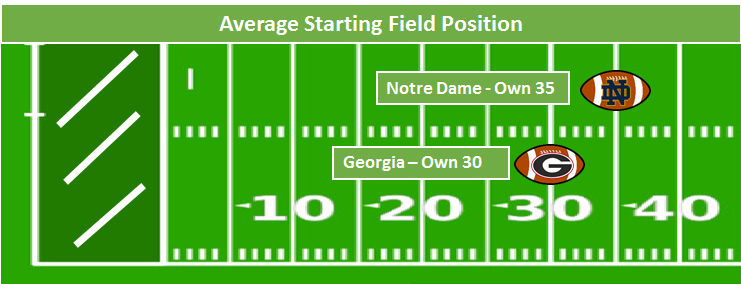
Field position was an area of a decent advantage for the Irish, thanks to a terrific game by Jay Bramblett and some miscues by Georgia’s punt unit. Both teams took advantage of turnovers deep in opponent territory, Notre Dame had great coverage on the the few kickoffs returned in the game, and punting (47.5 average for Bramblett, vs. 35.2 for UGA’s Jake Camarda) was the big difference.
By the box score the Irish were a little unlucky statistically to lose the turnover battle 2-1. It gets into a grey area because technically there were seven (!) fumbles in the game, but that counts snaps that weren’t clean and picked up by each QB. The Irish recovered three of these – the muffed punt, bad snap on 4th down to Book, and a fumble forced on Cole Kmet that the tight end recovered. The Irish also didn’t force many pass break ups (2) but had zero interceptions, meanwhile Georgia had slightly higher than expected interceptions (2) from their total of 8 PBU’s (average would be around 20% of breakups being interceptions).
A familiar feeling
The advanced stats show a program that’s just a tick below the level of UGA in the more sustainable categories like efficiency and explosiveness, which isn’t breaking news. The Irish did a lot of little things right – capitalizing on a free goal to go with a touchdown, winning field position battles, holding tight against a 1st round running back – but it wasn’t enough. We knew it would take near-perfect for an upset, and there was a lot of imperfect Saturday, whether in penalties, the lack of run game, or Fromm just outplaying Book by enough.
This game fits cleanly into an expanding folder in Brian Kelly’s file cabinet with 2014 FSU, 2015 Clemson, and 2017 UGA. All were close losses where the Irish acquitted themselves well against a top team but found themselves unable to push over the top. The uncomforting upside is that this program is to a place of stability where this result wasn’t by any means shocking – against the third most talented team in the nation, per the 247 Sports Talent Composite, the Irish had the ball on the road with a chance for a historic win.
Yet fans have to feel sore from the repeated bumps on their heads against what feels like the program’s ceiling – limitations in recruiting top-end skill position talent, a program-changing QB, and quality depth. It’s hard to reconcile these types of losses that are both indicative of positive things about program development but stern reminders of the challenges of winning at this level simply to make a playoff, never mind the low-odds proposition of then upsetting two teams this good or better in consecutive games to win a title.
There’s still much to look forward to though. Weaknesses should be preyed on and many potential daggers landed to the vulnerable underbellies of USC, Michigan, and Stanford. The defensive ends are going to break out and crush some quarterbacks, Kyle Hamilton will take away more possessions, and the pass game should smoke easier defenses as more weapons return. There’s no reason with this many young contributors and talented upperclassmen that haven’t played their best yet that this can’t be a top-5 team by season’s end. It may not end in the back to back playoff berths that were the team’s goal, but it could be damn fun along the way.




I thought the big problems for the Irish were turnover margin, penalties and running game.
I’d like to also suggest a big problem was margin of points scored
Turnover margin and penalties were definitely areas they couldn’t afford to lose. The running game I think all things considered was closer head to head (thanks to the defense) that expected.
But UGA was just a bit better across the board in efficiency, explosiveness, converting scoring opportunities – the biggest place ND capitalized was ability to string explosive pass plays together on a couple drives and creating an ok field position advantage. Those are good things but generally less reliable to recreate week to week. I think in the net it’s a positive that the Irish didn’t play their best and were right there, but there’s also not a lot of data to support that we were better than Georgia in this contest in many areas.
I liked your point about how Book really could benefit from a good running game. I cannot help but imagine the variety of hypothetical scenarios — what if they had recruited any stud RBs like they used to, and had a Julius Jones type in the backfield? What if they had another above average WR to put on the field right now like Austin?
It would help a lot – Book was really good on the RPO’s last year and it feels like they have been dialed down some this year. It’d also help the effectiveness of play action, which it also doesn’t feel (I dont’ have numbers there) hasn’t been prominent.
Another field stretching option at WR would be useful for sure to keep defenses from dialing in on Kmet. I do think Finke is also suffering from having to play more snaps essentially out of position on the outside instead of slot.
Interesting thing about play action. There are no numbers to support that a better run game (or even more rush attempts) actually influence the effectiveness of play action. This was the first, and pretty good, article I found, but I know there are more out there about this.
https://www.footballoutsiders.com/stat-analysis/2018/rushing-success-and-play-action-passing
Overall play action > not play action. So more play action is good. But apparently not many people realize that simply running more play action is better, irregahdless of anything else.
For a counter position, I’d suggest that some of the problems in the running game are not the fault of the O-line or RBs. As long as Book demonstrates the inability to hit a deep pass (or even threaten it) a couple time per game, defenses have no reason to keep their safeties back. On non-passing downs, they are free to stack the box, which obviously makes running 200+ yards a challenge. Sure, ND is lacking a superstar back. But the ones on the roster ought to be able to scratch for much better YPC than what we have seen so far this year.
Not sure how the team can adjust schematically, except for what Chip threw at them in the first half. Irish can punish aggressive defenses with TE crossing routes and screen passes, but that won’t help against a straight-up run stuffing defensive front. In short, I really think this team has an offense to match its bend-don’t-break defense. They’ll have to sustain drives to score points against decent teams, and we’ll be frustrated watching them come up short too many times each weekend.
Also, Book still seems a bit gun shy on RPOs. He’s settled down in the pocket as the season progresses, but seems skittish on the keep/handoff choice, making many RPOs look like conventional running plays. In the New Mexico game, we saw the backups hold the ball long enough to force a commitment from defenders. Book has shown this same skill in the past, but not yet this year. Several of the stuffed runs by RBs might have gone differently as keepers or passes.
I think one of the reasons it’s easy to be disappointed in Book (as good to very good) is just that in the last 10 years we have had some explosive playmakers on offense and that if we consistently had a QB as good as Book our offense could have been more of a difference maker. Now we have the QB but lack the playmakers around him.
It would be interesting to go back like 10 years and see the top 3 playmakers on offense and see how they compare. My suspicion is that they have been strong until very recently.